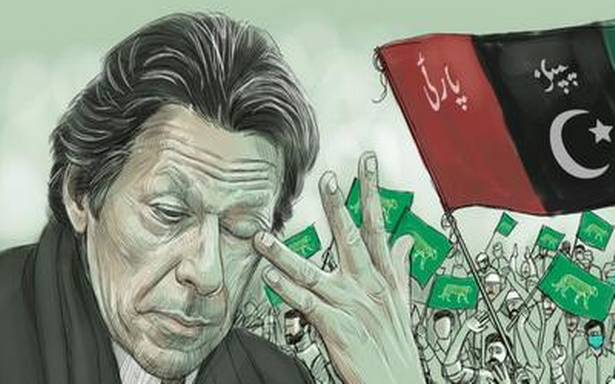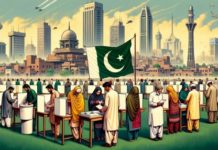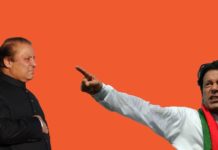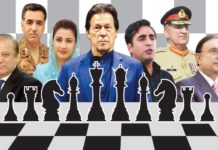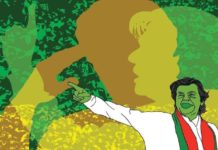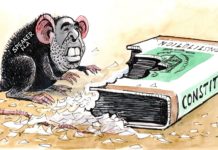Democracy in Pakistan is the stepchild of a widowed mother who is brought up in an uncle’s house. And the house is located at the edge of a mountain’s top. When the people of Karachi slept for hardly two hours in the heat of life, the news of Captain Safdar’s arrest opened their eyes.
The night is dark and such is the magic. The events are raging like a hurricane. It is a fact that in the four weeks since September 20, the decisive alignment of our political history has taken place. It is not possible for a common man to predict the events, however the direction of the situation can be told.
Some respected individuals who have the access to the corridors of power, give details of the events but even the decision maker can tell his intention, not the strategy of the opposing party. Politics is a kind of process that is formed by the interaction of countless factors.
The Constitution of Pakistan came into force on 14 August, 1973 and was suspended in July 1977. Giving the term of suspension to the repeal of the Constitution was the suggestion of the late Chief Justice Yaqub Ali. Suspicion is not a good thing. Justice Yaqub Ali probably wanted to find a middle ground between gun oppression and the future of the federation.
Constitution unfortunately is not ‘Tarbela Dam’ whose tunnels can be closed and opened at the discretion of the local engineer. The suspension of the constitution is a declaration of death for any sovereign state. Justice Yaqub himself was able to spend only seventeen days under this suspended constitution and was sent home on July 22, 1977. The gun does not understand the delicacy of the constitution, therefore, the gun is kept subject to the constitution.
This was the instruction given by Father of the Nation, Muhammad Ali Jinnah on June 14, 1948 at Command and Staff College, Quetta. We ignored this letter confidentially, which led to the unfortunate conclusion that the person who signed the Constitution of 1956 revoked it on October 7, 1958.
On the day Quaid-e-Azam’s Pakistan was divided, the promise of a self-made constitution was coming in the newspapers that very evening. Someone called the constitution a twelve-page booklet, another said that he saved the body of the nation by cutting off one organ of the constitution.
The owner of the ruling was not aware that a sovereign nation cannot tolerate the disruption of the system. Prosperity of its citizens, development of the economy and respect for the nation require supremacy of the constitution. Fulfilling this duty brings new requirements at every turn of history.
Let me tell you a story.
Bhutto had been hanged. The pen of the court and the hand of ‘Tara Masih’ (the executioner) were instruments of unseen intentions. The night was decorated with horrifying darkness. In such a situation, Mohtarma Nusrat Bhutto, Nawabzada Nasrullah and other leaders initiated the MRD movement (Movement for the Restoration of Democracy). General (retd) Tikka Khan was the Secretary General of the PPP.
The wounds of the military operation in Balochistan were still fresh. It was not possible to talk about democracy and not have Mir Ghous Bakhsh Bizenjo present. After the founding meeting of MRD in Lahore on February 6, 1981, a journalist asked Bizenjo:
How it felt to sit with Tikka Khan? The answer to this ploy was short, “This is the oppression of history.” Truth be told, democracy is the recognition of the oppression of history.
On the evening of October 18, pictures of Nawaz Sharif and Maryam Nawaz with PPP slogans were hung on the streets of Karachi. In her speech, Maryam Safdar addressed Bilawal Zardari as if explaining the basic principles of democratic politics. “You and I will fight elections against each other, but we will respect each other”. Though, the cruel past states otherwise.
Let me present some ground realities of the present moment. The shadow of the US-China economic war is affecting our region, including Pakistan. The economy of the current government arrangement has failed and there are verifiable figures for this statement. The mutual trust of the market and the city does not come from the teachings of ‘Siraj Teli’ (Pakistani industrialist). There is a strong consensus among the country’s established democratic forces. There are clear signs of underground conflict in the houses of power. The powers that have decided to resort to force rather than reconciliation.
In such a situation, the justification and manner of arrest of Captain Safdar has unveiled the intentions of this constitutional government. There is an interesting background to the 50-year-old law on the sanctity and protection of the Quaid-e-Azam’s mausoleum. On September 6, 1971, some government officials gathered at Mazar-e-Quaid and delivered a speech. At that time, Yahya Khan and Bhutto were discussing the constitutional crisis.
Bhutto was second to none in recognizing the moment of political initiative. Arrived at Mazar-e-Quaid on September 11, and delivered a soul-warming speech. There was a statement, “O Quaid, did you dream of a Pakistan in which we are not even allowed to cry at your shrine?” The draft of this speech is easily available. In response to Bhutto’s speech, the Yahya government had issued The Quaid Azam’s Mazar (Protection and Maintenance) Ordinance XXVII of 1971 on October 14, 1971. Those who arrested Safdar Awan have resorted to the law of Yahya dictatorship. As if they do not recognize the oppression of history.


